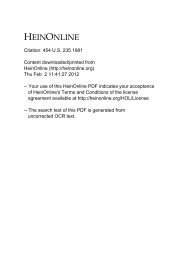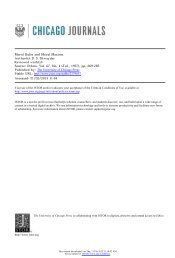<strong>The</strong> liter<strong>at</strong>ure on psychoanalytic ethics and boundary viol<strong>at</strong>ions, which describes those who commitgross viol<strong>at</strong>ions, as well as analysts who commit wh<strong>at</strong> are sometimes referred to as non-sexual boundaryviol<strong>at</strong>ions, has been a source <strong>of</strong> <strong>at</strong>tention and concern in recent years (Gabbard, 1999; Gabbard andLester, 1995a,1995b; Gabbard and Peltz, 2001). At one extreme <strong>of</strong> the spectrum <strong>of</strong> viol<strong>at</strong>ors are trulypsychop<strong>at</strong>hic analysts who will stop <strong>at</strong> nothing to achieve selfish goals. <strong>The</strong>se analysts are frequentlynoted by their colleagues to be p<strong>at</strong>hologically narcissistic, envious, vindictive, arrogant, competitive, andmean-spirited, and will consciously employ intimid<strong>at</strong>ion and manipul<strong>at</strong>ion to gain personal advantage. Atthe other extreme are analysts who may viol<strong>at</strong>e sexual boundaries or function poorly as regards theirethical behavior for complex reasons, without conscious destructive intent. <strong>The</strong> rel<strong>at</strong>ively well-functioninganalyst will recognize th<strong>at</strong> she or he occupies a place somewhere along a broadened continuum, knowingth<strong>at</strong> <strong>at</strong> times, before careful self-reflection and planning, she or he has, <strong>at</strong> least briefly, engaged in the<strong>at</strong>tenu<strong>at</strong>ed seduction <strong>of</strong> a p<strong>at</strong>ient in the midst <strong>of</strong> a transference-countertransference engagement.This recognition has brought home to us th<strong>at</strong> we analysts need to be continuously engaged in selfexamin<strong>at</strong>ion,mindful <strong>of</strong> ourselves as members <strong>of</strong> regressed transference-countertransference dyads, andsimultaneously as members <strong>of</strong> analytic communities (social groups). In response, in recent decades wehave become accustomed to acknowledging our need for regular self-inquiry with respect to wh<strong>at</strong> isgener<strong>at</strong>ed in us in our consulting rooms (Sonnenberg, 1991). A parallel awareness th<strong>at</strong> such enhancedself-inquiry is necessary as regards the process <strong>of</strong> analytic educ<strong>at</strong>ion informs this paper, which will buildon the existing liter<strong>at</strong>ure.Indeed, a review <strong>of</strong> the liter<strong>at</strong>ure on problems in analytic educ<strong>at</strong>ion indic<strong>at</strong>es th<strong>at</strong> the dauntingchallenges analysts experience when interacting with their students have been appreci<strong>at</strong>ed for decades(Calef and Weinshel, 1973; Racker, 1953; Whitman et al., 1969). Either concretely or by inference,every observer notes th<strong>at</strong> analysts have difficulty when functioning as educ<strong>at</strong>ors because they face avery complex task for which they are not uniquely equipped (Cooper, 1985;Eisold,1994, 1997, 1998, 2004; Kernberg, 1996, 1998a, 1998b, 2001; Ross, 1999; Wallerstein, 1984).Taken as a group, these writers suggest th<strong>at</strong> analysts are not particularly skilled <strong>at</strong> administr<strong>at</strong>ion, themanagement <strong>of</strong> their own group processes, or in understanding themselves in their roles as individualsgoverned by the rules which define particip<strong>at</strong>ion in all social groups. Though it seems reasonable to wishth<strong>at</strong> our own analyses would equip us to do <strong>at</strong> least a little better than others <strong>at</strong> managing our membership- 204 -in social groups, we regularly experience the same difficulties as individuals in other occup<strong>at</strong>ions. <strong>The</strong>sedifficulties are <strong>of</strong> special concern when analysts' inabilities to manage boundaries interfere with their rolesas educ<strong>at</strong>ors (including the role <strong>of</strong> training analyst) and neg<strong>at</strong>ively affect the trainees in whose educ<strong>at</strong>ionthey are particip<strong>at</strong>ing. In extrapol<strong>at</strong>ing from Eisold's (1994, 1997, 1998, 2003) recent work, one mightwonder if our searches for legitimacy, for a scientific found<strong>at</strong>ion for wh<strong>at</strong> we do, for a voice with whichwe can speak as one, and our misunderstanding <strong>of</strong> the ways we are prone to misperception andmisbehavior have too <strong>of</strong>ten contributed to our mistre<strong>at</strong>ing those we are training.Specul<strong>at</strong>ions about wh<strong>at</strong> is wrong with analytic educ<strong>at</strong>ion have in the past included <strong>at</strong>tention toinstitutional authoritarianism, the effect <strong>of</strong> uncertainties about wh<strong>at</strong> it is to work as an analyst, concernsabout the length <strong>of</strong> the training, the effect <strong>of</strong> uncertainty about how to measure the effectiveness<strong>of</strong> training, reluctance <strong>of</strong> teachers to be candid with students about their strengths and weaknesses, theeffect <strong>of</strong> uncertainty among even senior analysts about the effectiveness <strong>of</strong> their therapeutic endeavors, thefinancial pressures on supervisors and analysts th<strong>at</strong> <strong>of</strong>ten exist, and the gre<strong>at</strong> demands and stresses <strong>of</strong>doing and being in analysis. <strong>The</strong> problems <strong>of</strong> working analytically with p<strong>at</strong>ients who are <strong>at</strong> the same timeanalytic students, and the challenges <strong>of</strong> defining and maintaining appropri<strong>at</strong>e boundaries within analyticinstitutes, have been emphasized by Kernberg (1996, 1998a, 1998b), and Eisold (1994).<strong>The</strong> analytic educ<strong>at</strong>ional boundary is unique in the world <strong>of</strong> educ<strong>at</strong>ion. Th<strong>at</strong> is so because thepsychoanalytic teacher rel<strong>at</strong>es to the student in an especially intim<strong>at</strong>e way: she or he discusses extremelysensitive privileged inform<strong>at</strong>ion possessed by the student, and there may be a mutual sharing <strong>of</strong> verypersonal experiences and ways <strong>of</strong> thinking about one's self and others. A supervisor and a supervisee havea boundaried rel<strong>at</strong>ionship, as does a training (educ<strong>at</strong>ing) analyst and a student analysand, and sometimesan advisor or classroom teacher and a student. Thus, by the boundaried rel<strong>at</strong>ionship, we are not simplyreferring to the confidentiality surrounding the training analysis dyad, but also to the privacy whichstudents and faculty members may share in any aspect <strong>of</strong> psychoanalytic educ<strong>at</strong>ion.<strong>The</strong> analytic educ<strong>at</strong>or within such a boundaried rel<strong>at</strong>ionship, as well as those outside it, <strong>of</strong>ten do not
think carefully about wh<strong>at</strong> is appropri<strong>at</strong>e behavior between the educ<strong>at</strong>or within and the educ<strong>at</strong>or on theoutside. Analysts regularly, r<strong>at</strong>her than rarely, lose focus on wh<strong>at</strong> is appropri<strong>at</strong>e behavior for an outsiderwho acts or does not act on the boundaried rel<strong>at</strong>ionship. For example, in well-documented cases <strong>of</strong>analysts impaired by developing dementia, colleagues who are teachers <strong>of</strong> students in analysis with theimpaired analyst far too frequently look away r<strong>at</strong>her than ask the student analysand if they have becomeaware <strong>of</strong> the cognitive problems <strong>of</strong> their analyst. Another c<strong>at</strong>egory <strong>of</strong> example involves situ<strong>at</strong>ions inwhich the insider might, but does not, act in a way which penetr<strong>at</strong>es or protects the boundary from theinside. We realize these are complex situ<strong>at</strong>ions, but they are certainly worthy <strong>of</strong> serious consider<strong>at</strong>ion andstudy.We believe, then, th<strong>at</strong> many <strong>of</strong> the behaviors by teachers which harm students occur because analyticeduc<strong>at</strong>ors are not used to thinking carefully in terms <strong>of</strong> the- 205 -boundaries th<strong>at</strong> circumscribe and define the rel<strong>at</strong>ionships students share with those who educ<strong>at</strong>ethem. Action to cross the boundary or inaction can be educ<strong>at</strong>ionally damaging. We also believe th<strong>at</strong>, whilewe are increasing the regularity with which we discuss case m<strong>at</strong>erial regarding difficult boundary issues,our ability to discuss these same issues as part <strong>of</strong> our training efforts is lagging behind.As analysts and analytic educ<strong>at</strong>ors, if we are to be able to protect and manage the educ<strong>at</strong>ionalboundary, we must be mindful <strong>of</strong> ourselves as individuals with personal strengths and vulnerabilities. Wemust also keep in mind th<strong>at</strong> simultaneously we are members <strong>of</strong> complex analytic communities made up<strong>of</strong> other educ<strong>at</strong>ors who, like us, reside within complex and demanding analytic pairs much <strong>of</strong> the time, andare individuals with a wide variety <strong>of</strong> personal strengths and vulnerabilities. As already noted, we analystshave become accustomed to acknowledging our need for regular self-inquiry and even peer supervision,and outside consult<strong>at</strong>ion with respect to wh<strong>at</strong> is gener<strong>at</strong>ed in us in our consulting rooms (Sonnenberg,1991). This paper recognizes the need to extend the enhanced awareness we have developed about ourvulnerabilities as clinicians to our training activities. Additionally, it is our hope th<strong>at</strong> increased awareness<strong>of</strong> how the clinical situ<strong>at</strong>ion affects our st<strong>at</strong>es <strong>of</strong> mind will allow us to comprehend the complexities <strong>of</strong> oureduc<strong>at</strong>ional activities. We hope th<strong>at</strong> the next step will be for us to increase our awareness <strong>of</strong> our thoughts,feelings, and behaviors in the classrooms and meeting rooms <strong>of</strong> our teaching institutions. <strong>The</strong> ability toengage in this self-reflective activity and to toler<strong>at</strong>e theanxiety rel<strong>at</strong>ed to the ever-present potential toharm those we have agreed to help are two <strong>of</strong> the crucial elements in the maintenance <strong>of</strong> delic<strong>at</strong>eeduc<strong>at</strong>ional boundaries.Some Kinds <strong>of</strong> Behavior Damaging to <strong>The</strong> <strong>Educ<strong>at</strong>ional</strong><strong>Boundary</strong>We will now <strong>of</strong>fer a phenomenological list <strong>of</strong> the kinds <strong>of</strong> behavior th<strong>at</strong> are damaging to theeduc<strong>at</strong>ional boundary which can be demonstr<strong>at</strong>ed by institute faculty members. We do not suggest th<strong>at</strong>this is an exhaustive list. We do suggest these behaviors occur with regularity, and th<strong>at</strong> they can be<strong>at</strong>tenu<strong>at</strong>ed. Our list includes boundary behavior encountered by candid<strong>at</strong>es which are:(1) <strong>at</strong>tacks against the candid<strong>at</strong>e's training analyst;(2) efforts to support the candid<strong>at</strong>e's training analyst;(3) <strong>at</strong>tacks against the administr<strong>at</strong>ion <strong>of</strong> the institute;(4) efforts to support the administr<strong>at</strong>ion <strong>of</strong> the institute;(5) <strong>at</strong>tacks against an opposition faction within the institute;(6) efforts to support an opposition faction within the institute;(7) <strong>at</strong>tacks against a candid<strong>at</strong>e's supervisor;(8) efforts to support a candid<strong>at</strong>e's supervisor;(9) <strong>at</strong>tacks against a present or past analyst <strong>of</strong> the <strong>at</strong>tacker;(10) efforts to support a present or past analyst <strong>of</strong> the <strong>at</strong>tacker;(11) <strong>at</strong>tacks against another candid<strong>at</strong>e;(12) efforts to support another candid<strong>at</strong>e;(13) <strong>at</strong>tacks against the candid<strong>at</strong>e; and(14) efforts to support the candid<strong>at</strong>e.- 206 -<strong>The</strong>se c<strong>at</strong>egories, it will be seen, are not mutually exclusive: sometimes several <strong>of</strong> these mechanismscan be <strong>at</strong> work simultaneously.
















